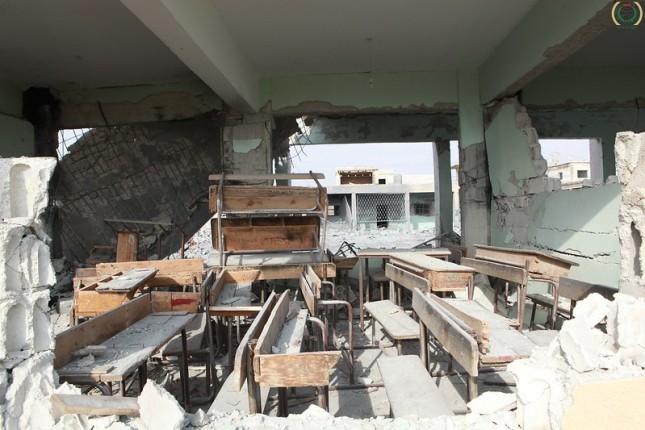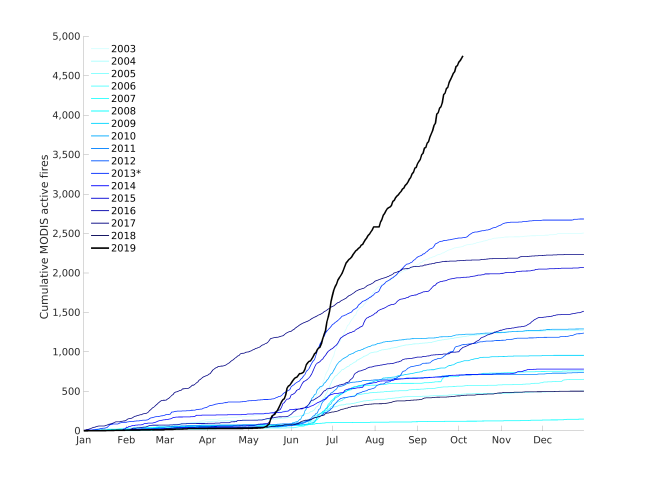-
How Fires Threaten Syria’s Security

Fires are proliferating. By the end of September, over 4,500 active fires had been detected in Syria during 2019. From May through June, 2,106 of these fires burned in northeastern Syria—Raqqa, Deir ez-Zour, and Al-Hasakeh – as documented by the nongovernmental organization, REACH. Meanwhile, widespread fires in Brazil’s Amazon rainforest caused global alarm. World leaders are becoming increasingly concerned about the environmental threats posed by increased fires, but Syria’s fires may also be linked to security threats.
Security Threat
Fires in conflict zones pose a unique security threat, one that combines social and environmental factors. This security threat includes three dimensions, which we can illustrate with the Syrian case. First, fires threaten physical well-being. In Syria, although it seems that fewer than 50 people were killed directly by fire in 2019, it is still a significant loss of life that has been overshadowed by ongoing violent conflict.
Second, fires threaten food security and economic livelihoods. In northeastern Syria as of early August, fires are estimated to have destroyed more than US$33 million of crops and more than 110,000 acres of cropland. Third, fires threaten information integrity, as rumors and conspiracy theories proliferate as people attempt to explain them. Like alleged incidents of food and water poisoning that are often behind riot-inciting rumors, it can be extremely difficult for people to accurately attribute fires to a specific perpetrator or cause. Speculation about Syria’s fires has proliferated, often without evidence. Conflicting narratives have guided this speculation, as people have blamed ISIS, the Assad government, Iran, and Kurdish militias for the fires. In one man’s words:
“We can’t say who is doing it,” he said. “Is it Arabs? We can’t say. Is it Kurds? We can’t say. Is it the government? We can’t say. Is it Turkey? We can’t say. Is it foreigners? We can’t say. There are many enemies, and we have no proof.”
Environmental Factors
We can also use the Syrian case to illustrate how social and environmental factors contribute to fire patterns. Importantly, this requires a combination of data sources and analytical methods. Using remote sensing data to examine environmental factors, we can observe Syria’s fire patterns from 2003 to 2019 (see figure below). We also draw from qualitative evidence to examine social factors unfolding on the ground.
Environmentally, we agree with many analysts that climate change and variability need to be considered, but it is far from the whole story. As the figure below shows, fire in Syria follows a clear seasonal trend in most years, with fires beginning in May and continuing through July. This regular seasonal trend makes it easy to understand when environmental conditions are prime for fire ignition and spread. Meanwhile, climate change is not simply increasing the amount of fires over time. In fact, fires actually decreased in most cases for the periods 2003–2009 and 2013–2016. The fire trend in 2017 departs from the general seasonal pattern. So far, fires in 2019 have conformed to Syria’s seasonal fire trend, but there have been far more fires than in previous years (See figure). This suggests that environmental factors contribute to Syria’s fire patterns in 2019, but social factors may be exacerbating the situation.
Figure. Daily cumulative active fire totals over Syria, 2003–2019

Social Factors Exacerbate Fires
Socially, four factors should be considered: 1) poor emergency response, 2) low quality fuel, 3) lack of skilled agricultural labor, and 4) ISIS attempts to destabilize communities. These fires have most frequently been attributed to ISIS. While it’s true that ISIS actively started many fires in Syria and Iraq, But, it did not start all of them. In Syria’s northeast, some blame a lack of skilled agricultural labor. There may be some truth to that. As one farmer noted, people operating combine harvesters were new in the sector:
“These drivers sometimes throw lit cigarettes into wheat fields, because they don’t know better. The old ones knew to carry water bottles to put out their cigarettes.”
In addition, Kurdish forces who currently govern many areas in northeastern Syria provide farmers with low quality fuel. A farmer claimed that bad fuel caused a fire on his land:
“I know that the fire on my land came from sparks, because it happened while the combine was gathering wheat,” said an Arab farmer in Raqqa, dismissing the notion that Kurdish actors had deliberately set his land ablaze. “The people harvesting my wheat are Arabs from my village. So I don’t blame the Kurds for starting the fires, but I do blame them for failing to provide good fuel.”
Furthermore, when fires start, Kurdish forces have provided ineffective emergency responses. “Firefighters aren’t available like before,” said an agricultural engineer in Homs. “The municipality has stopped trimming dry grass to prevent fires, because they lack capacity and oversight. This is the result of the war, and it will be very difficult to reverse.”
Acknowledging the complex interactions of social and environmental factors that influence fire patterns will improve policy responses to them. Climate change will alter ecosystems in ways that could make fires more frequent and more severe, but humans can strongly influence fire patterns as well. Policy responses that do not consider both social and environmental factors will be incomplete and ineffective.
Justin Schon is a Postdoctoral Scholar at the University of Florida. jschon@ufl.edu
Robert D. Field is an Associate Research Scientist at Columbia University. robert.field@columbia.edu
Michael J. Puma is Director of Columbia University’s Center for Climate Systems Research. mjp38@columbia.eduSources: BBC, NASA, REACH, Synaps Network, The Daily Beast, “The Deadly Ethnic Riot” by Donald Horowitz, The Washington Post.
Photo Credit: Damaged building in Taftanaz, Syria, January 2013. Courtesy of IHH Humanitarian Relief Fund.
 A Publication of the Stimson Center.
A Publication of the Stimson Center.




